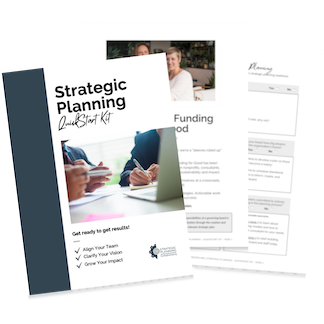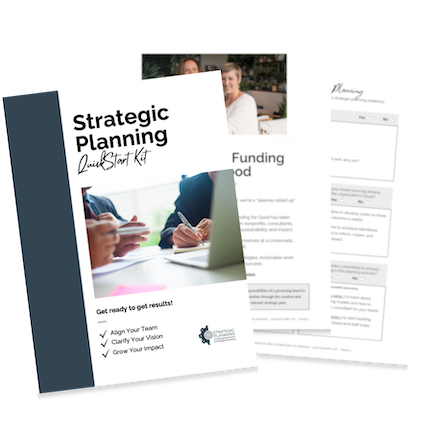Finding that elusive balance of passion, expertise, and productivity is a quest that keeps nonprofit boards stressing and striving annually. Acknowledging current nonprofit leadership trends and the current realities within your own board culture is the first step to improving board dynamics and impact.
The board governance model is one of the most widely adopted leadership models in the nonprofit sector. This model assigns three primary governance functions to the board:
- Establish direction through strategic planning and thinking
- Provide oversite
- at the micro-level if the organization has no executive staff.
- at the macro-level if the board has hired an Executive Director (ED) to manage daily operations.
- Ensure resources required to fulfill the organization’s mission.
While the model is in theory quite simple, over 53% of nonprofits nationwide struggle to find individuals willing to serve on the board. Nonprofits seek board members who are passionate about the mission, able to contribute significant time and personal resources (time, talent, and treasure), and willing to assume the legal and ethical duties of the leadership role.
The icing on the cake?
Board members are expected to serve as volunteers and make an annual financial gift! Essentially, nonprofits are asking leaders to PAY to work for them!
(Note: While the federal government does not prohibit nonprofit organizations from compensating board members, many states do have laws preventing organizations from paying board members for their governance services.)
What could possibly go wrong with a leadership model like this?
Nonprofits often settle for “filling empty board seats,” which creates a leadership culture of inexperience and unaccountability.
In 2020, “almost 49% of all chief executives said they did not have the right board members to “establish trust in the communities they serve.”
Only 32% of boards place priority on “knowledge of community served” and even fewer, 28%, placed priority on membership within the community served.” (Board Source 2021 Survey)
Can you imagine a for-profit business frantically appointing volunteers with minimal experience and training to their leadership board? Would a for-profit CEO relinquish the reigns of power to untrained and inexperienced volunteers and expect them to oversee executive-level employees, marketing, and finances?
Absolutely not. Yet nonprofit organizations regularly appoint inexperienced, uninformed, and untrained leaders to the governing board.
Now that we have acknowledged national board leadership trends, we will address the top things boards should know to improve internal leadership dynamics:
1. Nonprofit ARE businesses.
While your organization may be purpose-driven, it is impossible to fulfill your mission without a business plan and resources to achieve your goals.
One of the most fundamental functions of the nonprofit board involves establishing direction and “planning.”
-
- Do you understand your communities’ needs?
- Have you reviewed and approved a vision and mission statement that is clear, current, and relevant?
- Have you collaborated with the staff/stakeholders to develop a strategic plan to sustain, improve, and grow your organization over the coming years?
- Has your board established policies and procedures to mitigate risks and maximize the organization’s success?
2. A nonprofit cannot create a lasting impact without strong leadership.
-
- Have you assessed what skill sets you need from leadership?
- Have you established an intentional onboarding process to ensure board members bring the passion, expertise, and willingness the organization needs overcome obstacles and achieve strategic plan goals?
- Do you equip and empower your board through targeted training and hands-on experience?
- Have you conducted regular, thorough, and honest assessments of the board’s performance?
- Do you have a system for holding the board accountable, and are you using it?
- Has your board developed an intentional process to hire, supervise, and support an Executive Director?
(53% of nonprofit boards nationally do not have a formal compensation plan for the ED, and 78% of current ED’s state they are working without a signed contract. (Board Source 2021 Survey)
3. “Nonprofit” is your Tax–Status but should NOT be your operating model.
Just as for-profit businesses must plan and create budgets, a nonprofit board is responsible for approving a realistic annual operating budget. Rather than “rubberstamp” budgets and fundraising campaigns, it is essential to question:
-
- Does the annual operating budget accurately project our daily operational needs?
- Does the budget consider capacity-building projects and special expenses required for this year’s strategic plan goals?
- Do we have diversified funding streams?
- Are we over-dependent on a specific funding stream?
- How can we help raise the resources needed to fulfill the mission? (raise dollars, leverage in-kind support, utilize personal connections, etc.)
Serving on a nonprofit board can be one of the most rewarding or frustrating experiences in the leadership world. The questions above offer a helpful starting point for board dialogue.
At Funding for Good, we encourage leaders to acknowledge current realities without dwelling on them. Do not dedicate extended time to explaining a past you cannot change. Instead, take the time to dig deep, acknowledge your board’s leadership culture, and focus energy on “what can we do better?”



